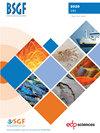The Piolit, Pelat and Baiardo Upper Cretaceous flysch formations (western Alps): geodynamic implications at the time of the Pyrenean tectonic phases
IF 2.6
3区 地球科学
Q2 GEOSCIENCES, MULTIDISCIPLINARY
引用次数: 4
Abstract
The Piolit, Pelat (French Alps) and Baiardo (Italian Maritime Alps) units contain Upper Cretaceous carbonate turbidites formations, with minor siliciclastic components. They are flysch formations, linked with the Pyrenean compressive events through their ages and their “subbrianconnais” structural position. Sedimentological, mineralogical (heavy minerals), and geochemical analysis, point to a potential “Pyrenean signature” which would testify the Late Cretaceous collision between the Ibero-Brianconnais terrane and the European plate. A “Dauphinois” origin and basin inversion erosion is proposed for the zircon-tourmaline-rutile (ZTR) bearing Piolit flysch, deposited from the Coniacian to the Campanian. A Penninic origin with tectonic inversion and erosion of former tilted blocks of the European margin from the Turonian to the Paleocene is proposed for the ZTR bearing Pelat flysch. Comparison with the Niesen (Swiss Prealps) and La Ciotat (Provence) flysch depositional context, allows to better constrain the Pyrenean compressive event in the Alpine domain. The Senonian part of the Baiardo flysch, that contains a garnet-dominated heavy mineral association and distinct geochemical trends, is allotted to the Liguro-Piemontais domain and to the Alpine collision stricto sensu.上白垩统Piolit、Pelat和Baiardo复理石组(西阿尔卑斯山):比利牛斯构造期的地球动力学意义
Piolit、Pelat(法国阿尔卑斯山脉)和Baiardo(意大利滨海阿尔卑斯山脉)单元包含上白垩统碳酸盐浊积岩地层,其中含有少量的硅屑成分。它们是复理石质地层,与比利牛斯山脉的挤压事件及其“亚brianconnais”构造位置有关。沉积学、矿物学(重矿物)和地球化学分析指出了一个潜在的“比利牛斯山脉特征”,它将证明晚白垩纪伊比利亚-布里安康纳斯地块与欧洲板块之间的碰撞。认为含锆-电气石-金红石(ZTR)的皮奥利特复理石沉积于Coniacian - Campanian,具有“Dauphinois”成因和盆地逆蚀作用。认为含ZTR的Pelat复理石为盆地成因,其构造逆转和原欧洲边缘倾斜地块的侵蚀作用自Turonian至古新世。与Niesen(瑞士前阿尔卑斯山脉)和La Ciotat(普罗旺斯)的复理石沉积背景比较,可以更好地约束阿尔卑斯地区比利牛斯山脉的压缩事件。Baiardo复理石的Senonian部分,以石榴石为主的重矿物组合和明显的地球化学倾向,严格意义上属于Liguro-Piemontais域和Alpine碰撞。
本文章由计算机程序翻译,如有差异,请以英文原文为准。
求助全文
约1分钟内获得全文
求助全文
来源期刊
CiteScore
5.80
自引率
0.00%
发文量
18
审稿时长
>12 weeks
期刊介绍:
BSGF - Earth Sciences Bulletin publie plusieurs types de contributions :
1. des articles originaux, couvrant tous les champs disciplinaires des Géosciences, à vocation fondamentale mais également à vocation plus appliquée (risques, ressources);
2. des articles de synthèse, faisant le point sur les avancées dans un domaine spécifique des Géosciences, qu''elles soient méthodologiques ou régionales ;
3. des monographies sur la géologie d’une région donnée, assorties d’informations supplémentaires, cartes, coupes, logs, profils sismiques … publiées en ligne en annexe de l’article ;
4. des articles courts de type « express letter » ;
5. des livrets-guides d’excursion (qui suivront le même processus d’examen éditorial que les articles plus classiques) ;
6. des comptes rendus de campagnes à la mer ;
7. des articles de données géodésiques, géophysiques ou géochimiques, pouvant devenir des articles de référence pouvant conduire à des interprétations ultérieures.
BSGF - Earth Sciences Bulletin constitue également un forum pour les discussions entre spécialistes des Sciences de la Terre, de type comment-reply ou autre. Tous les articles publiés, quelle que soit leur forme, seront accessibles sans frais (articles en Open Access) sur le site de la SGF et sur celui de Geosciences World dans la mesure où les auteurs se seront acquittés d’une contribution de (Article Processing Charges – APC) de 300€ pour les membres de la SGF et 500€ pour les non-membres.

 求助内容:
求助内容: 应助结果提醒方式:
应助结果提醒方式:


